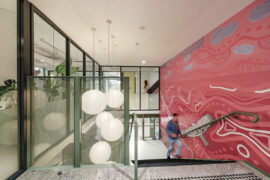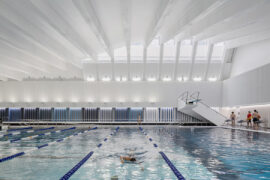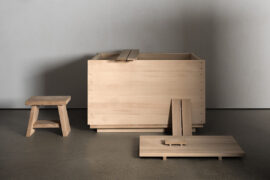Added value from great design takes on new meaning at UTS Central, making the campus once again an essential daily experience.

July 6th, 2020
Like RMIT in Melbourne, the University of Technology Sydney (UTS) is an urban campus. But when it was founded in 1988, it was more of a suburban campus, as the city edge essentially ended at Central Station.
What is interesting about UTS today is that it not only responds to the recent urbanisation of Sydney CBD’s south-western edge, but has become an increasingly important driver of local urban regeneration as light industrial and commercial sites have transformed into a vibrant mix of high-rise residential, retail and hospitality accompanied by the re-invention of the streetscape. The UTS building and landscaping programme, in conjunction with a policy to maintain a high level of porosity both visual and through welcoming public access, is playing a major role in the transformation of the Ultimo precinct.

Green space is still in short supply, but that was partly remedied in 2014 when UTS’s Alumni Green opened, an extended 1,200-squaremetre landscaped green square which separated Buildings 1 and 2 (facing Broadway) from the Faculty of Science and Graduate School of Health Building.
The original plan was to add floors on top of Building 2, but it became clear that here was an opportunity to re-imagine the entire precinct by starting afresh. The new building, UTS Central, designed by fjmtstudio, the original podium design by Lacoste + Stevenson with DJRD, is seamlessly connected to architect Michael Dysart’s imposing 1969 ‘brutalist’ Building 1. In fact, for fjmt Design Director Richard Francis-Jones, it is now much easier to appreciate the Dysart building. While both buildings share a modernist aesthetic, the lightweight, curvilinear and transparent quality of the new building helps Building 1 to be “less dominant and more balanced”.


fjmt conceptualised the new building around the relationship between the ‘campus grid’ (Alumni Green) and the ‘city grid’ (Broadway) aiming to generate as much connection as possible. As project lead James Perry puts it: “This building has to sit in a campus and in a city. How do you do that?”
So, they “tore the podium (extending up to Level 7) apart and took the tower all the way down to the ground”. To connect the two grids they rotated the tower with each floor stepping back to ensure that the building does not compromise access to sunlight for the Green Square apartments on the southern side of Broadway.

Building 1 is a heavy, rectilinear, concrete brutalist building; fjmt set out to do exactly the opposite with Building 2 – something very curvilinear, very white. A closed-cavity glass façade system enabled them to have performance glass on the inside and clear glass on the outside with automated white blinds in between. This activates the building from Broadway where passers-by can clearly see activities in the broad perimeter student areas, which form an edge to the main teaching spaces.
On the northern side of the building is the library and triple-height reading room, championed by the Vice-Chancellor Professor Attila Brungs, who wanted a “contemporary reading room”, a very quiet collegiate space.
The library spaces epitomise the strategy of drawing natural light deep into the building in order to optimise the sense of connection to the outside. This is achieved by the use of glass-cavity walls, skylights and three double-helix transparent spiral staircases. The staircase that connects the library and the reading room is half inside the building and half outside; it acts, says Perry, like “an inverted skylight”. From here people inside can look down on Jones Street and Broadway, while those outside the building can look up into it. Basically, it de-materialises the corner of the two streets.


“We wanted to make it a sculptural element,” says Perry, “because it is so visible from the street. In fact, from the street you can’t see that it is a staircase; you can’t see the treads or the handrail. The balustrading is solid all the way up, so you can’t see where the landings are. But you can see people moving up and down.”
Both inside and outside, UTS Central is imbued with a curvilinear or organic aesthetic. Inside, the building is constantly unfolding and revealing new spaces, all clad in American Oak laminate to combine warmth and robustness. This supports a programme that provides a rich diversity of spaces for students to meet, study in small groups or work alone. Circulation is pushed to the perimeter, lifts are positioned to encourage people to use the escalators and east-west connection between the two buildings and north-south between the Broadway and Alumni Green sides of the building is sustained by through views – although the views are never completely direct. Rather they are somewhat circumlocutory, creating the impression that moving through the building is a constant voyage of discovery.
Surely, this is a kind of phenomenology of learning: a constantly stimulating learning space that both reflects and embodies the nature of learning as discovery.

Indeed, UTS Central is at the cutting edge of tertiary education. It is a vertical campus, but one that reconciles both the vertical and horizontal spatial experiences. While it offers a variety of small-scale learning spaces, it also offers large-scale learning environments such as the collaborative classrooms on the southern side. One, on Level 5, accommodates 350 people. Driven by Deputy Vice-Chancellor, Professor Shirley Alexander, they aim to thoroughly change the way teaching works by offering a diversity of learning and instructional experiences. The idea is to make realtime teaching and learning attractive again, and lessen dependence on isolated online information-gathering.
The jewel of UTS Central is the library and reading room, three double- and triple-height volumes directly connected over three levels by a double-helix spiral staircase. These light-filled spaces, with their custom-designed furnishings in American Ash and green terraces, are oases of reflective calm while remaining fully connected visually to the outside by the cavity glass façade and skylights. They continue the aesthetic of flowing, curvilinear walls – even the stacks meander in a reminder that “books do furnish a room”.

Facing north, the sun was a potential problem – although it also offered the opportunity for a wintergarden. TILT’s mix of fixed and automated metal louvres with leaf patterning provides the solution. It brings with it a decorative element, visually enhancing the louvres whether seen from inside or outside and supporting the overall organic aesthetic of the building.
UTS Central offers a unique educational experience. It is an urban campus, but without the forbidding industrial aesthetic we usually associate with this model. Instead we have a humanised and stimulating physical environment coupled with best pedagogical practice.
Access the complete issue of Indesign #81, the Education Issue, here.





INDESIGN is on instagram
Follow @indesignlive
A searchable and comprehensive guide for specifying leading products and their suppliers
Keep up to date with the latest and greatest from our industry BFF's!

Merging two hotel identities in one landmark development, Hotel Indigo and Holiday Inn Little Collins capture the spirit of Melbourne through Buchan’s narrative-driven design – elevated by GROHE’s signature craftsmanship.

For a closer look behind the creative process, watch this video interview with Sebastian Nash, where he explores the making of King Living’s textile range – from fibre choices to design intent.

At the Munarra Centre for Regional Excellence on Yorta Yorta Country in Victoria, ARM Architecture and Milliken use PrintWorks™ technology to translate First Nations narratives into a layered, community-led floorscape.

From radical material reuse to office-to-school transformations, these five projects show how circular thinking is reshaping architecture, interiors and community spaces.

We republish an article in memory of the late architect by UTS, whose Dr Chau Chak Wing Building was Gehry’s first built project in Australia. The internationally revered architect passed away on 5th December.

Hiwa, the University of Auckland’s six-storey recreation centre by Warren and Mahoney with MJMA Toronto and Haumi, has taken out Sport Architecture at the 2025 World Architecture Festival. A vertical village for wellbeing and connection, the project continues its run of global accolades as a new benchmark for campus life and student experience.
The internet never sleeps! Here's the stuff you might have missed

From radical material reuse to office-to-school transformations, these five projects show how circular thinking is reshaping architecture, interiors and community spaces.

Jason Gibney, winner of the Editor’s Choice Award in 2025 Habitus House of the Year, reflects on how bathroom rituals might just be reshaping Australian design.